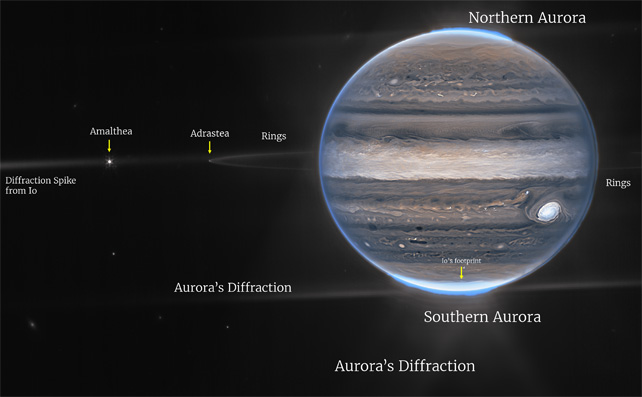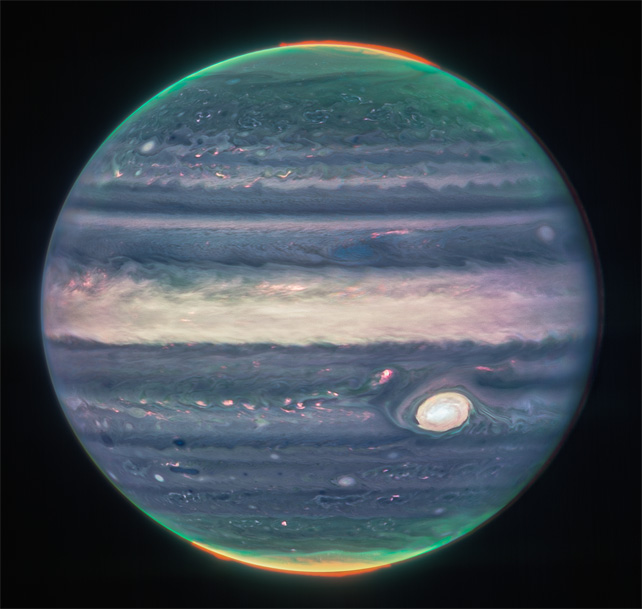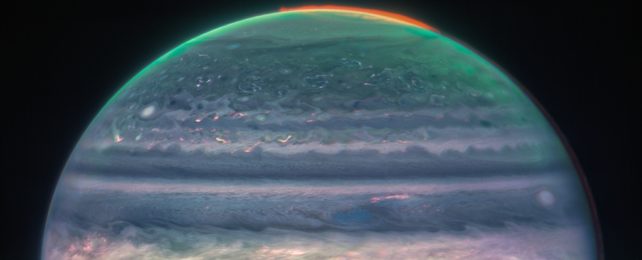Astronomers' new eye in the sky, the James Webb Space Telescope, has already captured images of the most distant galaxies ever seen.
Now, the powerful infrared observatory is providing mind-blowing views of our own cosmic neighborhood in snapshots released by NASA on Monday.
Images of Jupiter, captured on July 27, show the planet's turbulent atmosphere, with the gas giant's Great Red Spot – an enormous storm that has been swirling for centuries – along with other storm systems.
The telescope also spotted Jupiter's thin rings made of dust particles from debris, visible auroras at Jupiter's northern and southern poles, and two of the planet's moons, Amalthea and Adrastea. The fuzzy spots in the background are galaxies, according to NASA.
"We hadn't really expected it to be this good, to be honest," Imke de Pater, a planetary scientist at the University of California, Berkeley, who led the scientific observations of the planet, said in a statement.
"It's really remarkable that we can see details on Jupiter together with its rings, tiny satellites, and even galaxies in one image."

Often described as the successor to the Hubble Space Telescope, Webb launched on 25 December 2021, after more than two decades of development. Since that time, the $10 billion telescope has traveled more than 1 million miles from Earth and is now stationed in a gravitationally stable orbit, collecting infrared light.
By gathering infrared light, which is invisible to the human eye, Webb is able to cut through cosmic dust and see far into the past, to the first 400 million years after the Big Bang.
Webb captured the new Jupiter images using its Near Infrared Camera (NIRCam) filter.
The images were artificially colored to make specific features stand out, such as the planet's stunning auroras.

"These newly released JWST images of Jupiter are blowing my mind," James O'Donoghue, a planetary scientist from the Japan Aerospace Exploration Agency, said on Twitter.
"Incredible detail of the turbulent atmosphere, auroras at the poles, rings encircling the planet, tiny moons, and even some galaxies in the background!"
Auroras are colorful displays of light that are not unique to Earth. Jupiter has the brightest auroras in the solar system, according to NASA.
On both Earth and Jupiter, auroras occur when charged particles, such as protons or electrons, interact with the magnetic field – known as the magnetosphere – that surrounds a planet. Jupiter's magnetic field is about 20,000 times stronger than Earth's.
"This one image sums up the science of our Jupiter system program, which studies the dynamics and chemistry of Jupiter itself, its rings, and its satellite system," Thierry Fouchet, an astronomy professor at the Paris Observatory who led the observations, said in a statement.
Raw data collected during the telescope's commissioning period, before its science operations officially started on July 12, also included an image of Jupiter.
"Combined with the deep field images released the other day, these images of Jupiter demonstrate the full grasp of what Webb can observe, from the faintest, most distant observable galaxies to planets in our own cosmic backyard that you can see with the naked eye from your actual backyard," Bryan Holler, a scientist at the Space Telescope Science Institute in Baltimore, who helped plan the observations, said in a statement in July.
This article was originally published by Business Insider.
More from Business Insider: